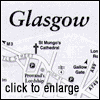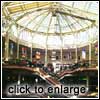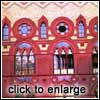|
Greater Glasgow And The Clyde Valley
Glasgow
Culture
There are few better examples of the power of public
relations than the transformation of image of the city of Glasgow. For decades Glasgow
was widely associated with hard drinking, pub brawling, massive unemployment and
decaying housing estates. Now, it is at the crest of Scottish culture, a leader in
the popular renaissance of fashion and a focu for theatre and the arts. There are
few people who visit Glasgow now-a-days who don't come away with a warm affection
for the place.
Social problems were endemic in this city, in large
part due to the demis of the once great steel and ship-building industries. These
ruled the banks of the Clyde for many decades but faltered in the Depression of the
1930s and gradually faded away between the 1950s and 70s.
These industries relied on tough, hard working characters,
plate-metal workers, welders and riveters who turned out the world's finest locomotives
and ocean liners. Drinking was always the shipyard worker's favourite hobby and it
must have been a terrible knock to their pride as well as their pay-packet to see
these great enterprises go down the river, so to speak.
 Following years of stagnation, the city began to accept that
shipbuilding and its associated industries were gone for good and new directions
had to be found. In the early 1980s the 'Glasgow's Miles Better' campaign started.
People who knew the city viewed the campaign with incredulity but soon it gained
momentum and support. Following years of stagnation, the city began to accept that
shipbuilding and its associated industries were gone for good and new directions
had to be found. In the early 1980s the 'Glasgow's Miles Better' campaign started.
People who knew the city viewed the campaign with incredulity but soon it gained
momentum and support.
By 1988 the Glasgow Garden Festival had brought hundreds
of thousands of visitors to the town and transformation was complete when the city
became the European City of Culture' in 1990. Now, 1999 marks another milestone when
the city becomes 'City of Architecture and Design'.
History
Glasgow's history stems back to the sixth century
when an ecclesiastical community was established by St Mungo. His church was built
on the site of the present Glasgow Cathedral. From this beginning, the town of 'Glas
Cau', meaning 'dear, green place', took hold and gradually spread over the many gradual
hills that surround the River Clyde.
Following the Treaty of the Union in 1707, trade with
the New World increased and Glasgow became one of the principal European ports handling
mainly tobacco and sugar. The Industrial Revolution brought activity such as textile
and chemical production but, with coal abundant in the seams of Lanarkshire to fuel
ironworks, the city took to a wide range of heavy industries, ship and locomotive
building being the most conspicuous. The Clyde, formerly a shallow river, was dredged
in the late 1700s and Glasgow became the world's leading shipbuilding centre.
In the 1840s Glasgow's population dramatically increased
when deposed Highlanders joined the thousands fleeing Ireland's potato famine. They
descended on the city to provide cheap labour. Upmarket residential areas such as
the Gorbals on the south side of the river were taken over to house working class
families. But, under a huge pressure of numbers and with little maintenance, these
estates quickly fell into decay and Glasgow's urban problems grew as quickly as its
wealth.
Nowadays, with their city spruced up and a positive
atmosphere in the streets, Glasgow's populous appear as chic as those in Rome or
Paris. Sitting outside the many coffee bars or browsing through art galleries scattered
throughout the town, their reputation for friendliness is only surpassed by their
trenchant sense of humour.
Getting around
 To best discover Glasgow, old and new, at least two to three
days are required. Try to avoid parking a car near the city centre although, if you
must, there is good parking facilities at the St Enoch Centre. Public transport,
in the form of taxis, buses and an underground train system, is more than satisfactory.
There is the circular subway euphemistically called the 'Clockwork Orange' or the
bus network with several companies, all in their own distinctive livery and often
heading for the same destination. To best discover Glasgow, old and new, at least two to three
days are required. Try to avoid parking a car near the city centre although, if you
must, there is good parking facilities at the St Enoch Centre. Public transport,
in the form of taxis, buses and an underground train system, is more than satisfactory.
There is the circular subway euphemistically called the 'Clockwork Orange' or the
bus network with several companies, all in their own distinctive livery and often
heading for the same destination.
St Enoch Travel Centre, housed in a fantastic, neo-Gothic
outhouse at the bottom of Buchanan Street, provides maps, timetables and helpful
travel information. The Visitor's Transport Guide is the best free map of the city
and West End areas. The easiest way to cover distances, of course, is by taxi.
It is also worth noting that there is a rapidly developing
Glasgow and Clyde Coast Cycle Route Network which can be used both in the city and
through to outlying areas as far as Ayrshire. Details are available from the tourist
offices.
Charles Rennie Mackintosh (1868-1928)
Charles Rennie Mackintosh was one of the most adventurous
architects of the turn of the century. Despite his working-class family's indifference,
Mackintosh managed to find a place at the Glasgow School of Art to study architecture.
He quickly developed a style which blended together elements of Gothic and Art Nouveau
with Scottish Baronial. His first important commission was the design of the furniture
and decor of a tea-room in Buchanan Street for a local business woman, Kate Cranston.
Although no longer in existence, a similar commission for the smae client still exists
at the Willow Tea Rooms at 217 Sauchiehall Street. During the summer months it trends
to be very busy, and is open from 9.30am until 5pm.
There are several other examples of his work in this
area, most notably the Glasgow School of Art where at the age of 28 he was asked
to submit plans for new premises. His 'modern' approach was not always appreciated
by the more stoic element in the city, and there was outcry when the building was
finally completed.
The Glasgow Scholl of Art in Renfrew Street is a short
walk from Queen's Cross Church. Francis Newbery, the principal of the college, encouraged
the board to accept their former student's designs and the Glasgow School of Art
was built in two stages between 1897 and 1909. This is the best example, both inside
and out, of Mackintosh's work. The exterior oriel windows stretch the length of four
floors, allowing considerable north light into studios. There is a mock-Baronial
east wing and a softer western half. Tours led by staff or students are available
four times a day during the summer and twice a day in the winter. The interior is
actually more fascinating than the outside with the usual Mackintosh touches, high
backed chairs and other unusual furniture. The Library is best appreciated looking
down from the Furniture Gallery.
Over the past 50 years the works of Charles Rennie
Mackintosh has been more locally appreciated. However since Glasgow's 1990 'Year
of Culture', it has gained wide popularity to the point that his elongated lettering
style, furniture design and relish for purple glass embellishments have become widespread.
Beside Glasgow there are other architectural examples of his work in Helensburgh
and Comrie.
City Tour
A good reference point for starting a tour of the
central and eastern side is Glasgow's Queen Street Station and George Square lying
at the heart of the city.
George Square
George Square, a spacious concrete piazza dotted with
trees and flower-beds and surrounded by wide streets, was also the heart of Victorian
Glasgow. At its centre is the 80ft (24m) high column and statue to Sir Walter Scott
who, in truth, had little to do with the town. The column had been intended for a
statue of George III but his failure to preserve the American Colonies along with
Glasgow's lucrative tobacco trade, saw this favoured plinth given to someone else.
Statues of Queen Victoria, Robert Burns and, the famous Scottish inventor, James
Watt, surround Sir Walter, besides hundreds of pigeons.
The Glasgow City Chambers form the eastern end of
the square, a magnificent Italian Renaissance citadel opened by Queen Victoria in
1888. Guided tours of the interior take place on weekdays at 10.30am and 2.30pm or
by arrangement. The inner halls and staircases abound with purple and red Italian
marble, mosaics, tinted glass windows and splendidly carved mahogany.
Glasgow's centre is well provided with quality shops.
Many are of the High Street variety, but there are plenty of independent stores of
good character. There are several book-shops such as Smith's or Waterstone's in St
Vincent Street and Buchanan Street which hold several good titles on the local area
and the Glasgow dialect known as the 'Patter'.
Three of the best shopping streets, Buchanon, Argyll
and Sauchiehall Streets, are partly pedestrianised. Buchanan Street is established
as the up-market shopping area while the glass-enclosed St Enoch's Centre at the
bottom of Buchanan Street offers the majority of well-known High Street outlets.
There is also a fast-food court and ice-rink there.
 Princess Square's stores, again in Buchanan Street, are more
individualistic with prices to suit along with pleasant, balcony cafes and restaurants
on the upper level. There is often a lunch-time concert taking place on the lower
lever. The nearby Argyle Arcade is a dated but inviting shopping mall specialising
in jewellery. Princess Square's stores, again in Buchanan Street, are more
individualistic with prices to suit along with pleasant, balcony cafes and restaurants
on the upper level. There is often a lunch-time concert taking place on the lower
lever. The nearby Argyle Arcade is a dated but inviting shopping mall specialising
in jewellery.
The Greater Glasgow Tourist Board is located near
the south-west corner of George Square on St Vincent Street. They provide a host
of booklets not only on Glasgow but on most parts of Scotland.
Eating out is easy in the town centre with a host
of good bars, cafes and restaurants with generally a very high standard of service
and food. Cappuccino side-walk bars are now found at various points, lending a continental
air. At the weekend, a unique market called the 'Barras' takes place at the east-end
just beyond Glasgow Cross, between Gallowgate and London Road. For collectors of
recent memorabilia and bargain hunters, the Barras are a stimulating experience.
Around the Cathedral
From George Square it is a 10-minute walk or a short
bus ride along George Street and left into Castle Street to Glasgow Cathedral. Before
you cross to the Cathedral, Prvand's Lordship, the oldest house in Glasgow dating
from 1471, sits on the corner of MacLeod Street and Castle Street. It is now a museum
but has performed many functions through its long existence, commencing as a refuge
for the poor then becoming a home for higher clergy. A small group of concerned locals
saved it from demolition in the early twentieth century and it now houses, amongst
other things, a rather out-of-place candy store display. More in keeping is an exhibition
illustrating the life of its original clients, the down-and-outs, prostitutes and
match-sellers of sixteenth century Glasgow.
The area surrounding the cathedral is the oldest part
of Glasgow where the first village sprung. St Ninian sanctified the site of Glasgow
Cathedral as a burial ground in AD397 and later St Mungo built a church. Dominating
the skyline today is a sooty-black and rather intimidating Gothic structure, the
cathedral itself.
So great was its early reputation that pilgrims made
their way here in medieval times. Traces of the original stone building was constructed
over a lengthy period until final completion in the late fifteenth century. Its fate
at the hands od Scotland's sixteenth century religious reformers did not look secure
so James Beaton, the last Catholic Archbishop, removed its treasures to France where
they were subsequently lost during the French Revolution.
Next to the Cathedral and looking almost as foreboding,
is the early twentieth-century Glasgow Royal Infirmary. To complete this ideal setting
for a Gothic horror film is the Western Necropolis, situated behind the Cathedral.
On a hill sternly overlooked by the statue of sixteenth century reformer John Knox,
the shadowy catacombs house the remains of wealthy nineteenth century merchants and
industrialists.
A brighter area to the front of the Cathedral has
been revitalised surrounding the new St Mungo Museum of Religious Life and Art which
brings together information and iconography of many of the world's religions. Salvador
Dali's Christ of St. John of the Cross has been moved here from Kelvingrove Art Gallery.
Scottish religion and life is generally examined, but there are no artefacts before
1800 due to the destructive nature of the Reformation. Outside the museum is a Zen
Buddhist Garden.
Following Castle Street south into the High Street,
Glasgow Cross, a seven storey Victorian rocket-ship, appears to obstruct the road.
This is Tolbooth Steeple, the centre of the medieval community. Across the road is
the entrance to the Tron Theatre, scene of many local productions and occasional
concerts and a popular watering hole. It was founded by the Glasgow Theatre Club
in 1979.
Glasgow Green
A short distance on towards the river brings you to
Glasgow Green. This wide swathe of grassland is said to be the oldest public park
in Britain. It was originally common grazing land for the medieval burgh, and Freemen
of Glasgow still maintain the right to graze their animals, although never do.
 More often, it has been a focal point for political and religious
meetings for many centuries. Both Nelson and Queen Victoria are captured in stone,
looking down on the proceedings. James Watt is said to have hit upon the idea of
a separate condensing cylinder for a steam engine whilst strolling here, and a boulder
marks the spot. More often, it has been a focal point for political and religious
meetings for many centuries. Both Nelson and Queen Victoria are captured in stone,
looking down on the proceedings. James Watt is said to have hit upon the idea of
a separate condensing cylinder for a steam engine whilst strolling here, and a boulder
marks the spot.
At the park's centre is the People's Palace, really
two structures, a huge glasshouse affair called the Winter Garden containing a wonderful
plant collection and a cafe that feels 'outdoor' even on a cool, rainy afternoon.
The square red-brick building holds an unusual museum with exhibits covering much
of Glasgow's history.
 Templeton's Carpet Factory, now Templeton Business Centre,
stands out across the street, a replica, so they say, of the Doge's Palace in Venice.
The fanciful exterior of the building gives some indication as to what Glasgow's
prosperous Victorian industrialists thought of themselves. Templeton's Carpet Factory, now Templeton Business Centre,
stands out across the street, a replica, so they say, of the Doge's Palace in Venice.
The fanciful exterior of the building gives some indication as to what Glasgow's
prosperous Victorian industrialists thought of themselves.
Near the Scottish Exhibition and Conference Centre,
with its reproduction-in-miniature of the Sydney Opera House, you see the black frame
of the Finiston Crane, once used for loading locomotives onto ships. These days it
is more likely to see a yacht sailing down the Clyde, than any working vessel. The
once busy docks and warehouses have been replaced with swanky hotels and trendy town-houses.
Entertainment
Should you wish to avail yourself Glasgow's night-life
(and it is recommended), up-to-date entertainment listings are found in the daily
Glasgow Herald or the Glasgow Evening News. There is also an entertainment guide
publication, the List, available from the Tourist Information Office or newsagents.
North of the city centre on Buchanan Street is the
Royal Concert Hall, a modern building regularly staging important events. The lobby
houses temporary art exhibitions. Guided tours of the hall and the backstage area
are available for a small cost.
Almost opposite the Willow Tearoom at 270 Sauchiehall
Street are the MacLellan Galleries hosting several major travelling exhibitions a
year. The halls were restored following a major fire in 1985. A wide spectrum of
events from around the globe is held here from local themes to major touring exhibitions.
The Third Eye Centre is a Grecian looking building
at 350 Sauchiehall Street and Scotland's largest and liveliest contemporary arts
centre, perhaps the main focus of the arts scene in the country. Opened in 1975,
the emphasis is on modern art as well as a small theatre for plays, music, films
and poetry readings. There are around thirty exhibitions per year including those
on international tour.
19th century time-capsule
Scotland's cities of the 19th century, in a bid to
provide more housing in over-populated urban areas, developed streets of tenement
blocks or flats, building upwards instead of horizontally. These became standard
accommodation for working class families and are still very much in evidence today
despite moves throughout the 1960s to demolish them. It was found that the sturdy,
stone built tenement accommodation was superior in many ways to the multi-storey
concrete blocks that replaced them.
The Tenement House at 145 Buccleuch Street in the
Garnet Hill area was the home of Agnes Toward who lived there with here mother from
1911 until she was hospitalised in 1965. Agnes threw little away and her house was
a treasure-trove of items used in the first half of the nineteenth century. The house
was discovered by an actress, Anna Davidson, who bought it to preserve the National
Trust for Scotland. Inside the original gas lighting has been reinstated and the
kitchen has a coal fuelled range with the coal-bunker standing near by. Agnes and
her mother cared little for modern appliances.
Devolution of Scotland
A referendum was held in September 1997 when the people
of Scotland voted to support the new Labour government's proposals to create a separate
Scottish Parliament.
Scotland has not had a Parliament of its own for almost
300 years. The Union of Scottish and English Parliaments in 1707 created a Parliament
of Great Britain meeting in Westminster in London. Scotland retained a separate legal
system with some control over such things as education but all else was considered
and decided from the south.
The present Government's mandate of modernising Britain's
administrative structure includes the devolution of power from Westminster to Scotland,
Wales and the English regions.
With the result of Referendum firmly in favour of
a Scottish Parliament with tax varying powers, the first elections to the Scottish
Parliament are scheduled for spring of 1999. The Scottish Parliament should be in
place by the year 2,000, giving real responsibility over Scottish affairs to the
people of Scotland.
Kelvingrove Park
Following Sauchiehall Street west leads to Kelvingrove
Park. This was the wealthy end of town in the 1800s, where merchant's estates were
set apart from the grime of the city. The River Kelvin cuts through this green oasis
and several notable buildings overlook it. Kelvingrove Park is handy for a game of
bowls, flying kites or just sitting around watching others.
There the massive Stewart Fountain commemorates the
Waterworks Act of 1855 when water was supplied to the city from Loch Katrine in the
Trossachs, thus improving the health of thousands of Glaswegians. The steep stairway
on the east side of the park leads to some of the most elegant Victorian houses in
the Park Circus area.
Glasgow Art Gallery and Museum was built to hold the
International Exhibition of 1901. The rear of the building faces the road, which
was a major blunder by the architect who flung himself off the building when it was
finished. It now houses one of the finest municipal collections of paintings in Britain.
The Glasgow School, or 'Glasgow Boys' as they liked
to be known, were active in the late nineteenth century, breaking new ground with
a fresh approach. Their paintings are well represented in the Art Gallery. Scottish
Colourists such as Peplo, Cadell and Fergusson are on display along with world famous
paintings such as Rembrandt's Man in Armour or Whistler's Portrait of Thomas Carlyle.
The ground floor displays an impressive internationally-renowned collection or arms
and armour including Scottish weaponry. The museum side includes important displays
in the fields of natural history and archaeology.
Directly opposite the museum and art gallery in Kelvin
Hall is the Museum of Transport. The huge space inside offers a rare glimpse of Glasgow's
transport systems through the decades. The world's oldest pedal cycle is suspended
above squadrons of bikes, bubble cars and other faddish modes of transport. The Clyde
Room is said to house the most comprehensive model ship collection in the world,
gathered from the builders and owners of the full-sized vessels. The 'test tank'
hull models of the QE1 and QE2 are on display.
On the ground floor there is a reconstruction of a
1930s street complete with butchers, bakers, an underground terminal and a cinema
which shows old footage of transport-related themes pertaining to Glasgow. Outside
there is a modern Super X simulator that mimics the more brisk methods of transport
such as down-hill skiing or white-water rafting.
The University of Glasgow
The Gothic towers and turrets of the University of
Glasgow stand at the other side of Kelvingrove Park and can be entered by crossing
the bridge to the left of Kelvin Hall and following the path leading up to the buildings.
Alternatively the front entrance is on University Avenue. Founded in 1451, it was
one of the three Scottish universities, St Andrews and Aberdeen being the others,
established around this time. It occupied several sites before it settled on Gilmorehill
overlooking Kelvingrove Park in 1870.
The front gates are fascinating. They 'grow' in five
stages showing the expansion of learning. The most notable graduates of the university
as illustrated on the gate include Lister, James Watt and Adam Smith, the economist
and moral philosopher.
Its mock Gothic centre-piece is surrounded by a variety
of important buildings such as the Bute Hall and the Hunterian Museum. The Hunterian
Museum, Scotland's first public museum dating back to 1807, is in the University's
main building and contains important geological and archaeological displays.
The Hillhead area
The Hunterian Art Gallery is in Hillhead Street and
contains Hunter's small but comprehensive collection of paintings, prints, and sculpture.
The outstanding collection by James Abbot MacNeil Whistler is bettered only in Washington
D.C.'s Freer Gallery. Prints by Hockney, Picasso and Durer can also be seen. A side
gallery has been used to reconstruct the interior designs of Charles Rennie MacKintosh's
home at 6 Florentine Terrace where he lived from 1906 to 1914.
The Hillhead area is popular with students and the
pubs and restaurants here are quite lively. There are several guest-houses and B&B's
in the area, while larger hotels are more generally found on nearby Great Western
Road.
The Glasgow Botanic Gardens to the west are frequented
on any sunny day by hordes of locals ready to strip off and soak up any sunshine.
Visitors tend to head for the Kibble Palace, originally known as the Crystal Palace,
the magnificent domed glass-houses at the park's centre.
Byers Road is the busiest thorough-fare in this part
of town with plenty of shops and pubs. The Ubiquitous Chip is one of the better known
eateries just off Byres Road in Ashton Lane with its cobbled courtyard restaurant
on the ground level and a labyrinth of bars above. The food can be pricey but is
always of high quality.
The south side
Personal transport might be the best way to explore
the south side of Glasgow as its attractions are well spread out although taxis from
the city centre are not prohibitively priced. The baronial Haggs Castle is yet another
free museum located on St Andrews Drive on the eastern approaches to the Burrell.
Built in 1585 and restored in the nineteenth century, it opened in 1976 as a period
museum for children, centring around educational activities.
Nearby is the Museum of Education at Scotland Street
School following a similar theme. The classrooms have been reconstructed to cover
different periods from the Victorian Age to the 1960s.
|





